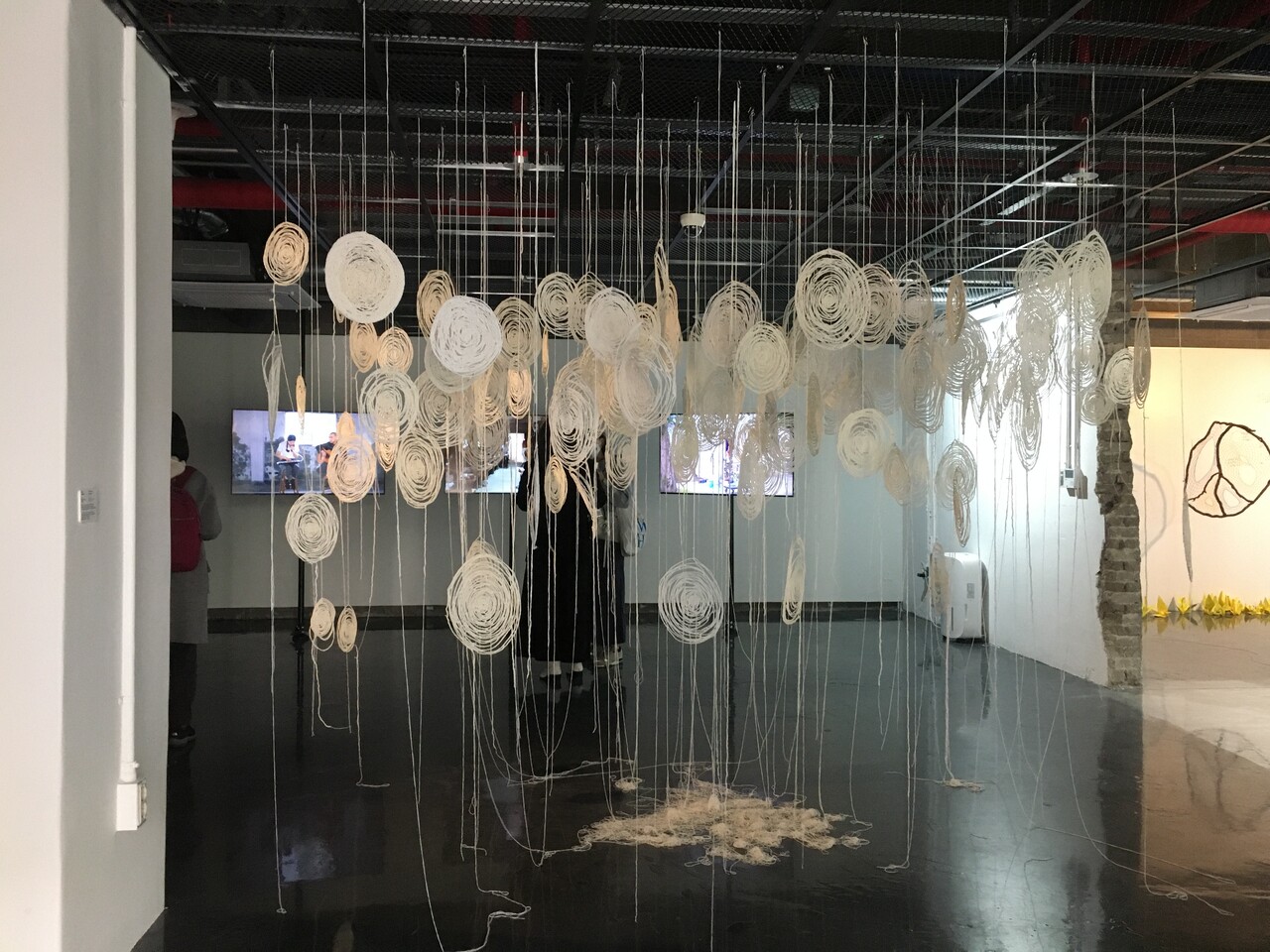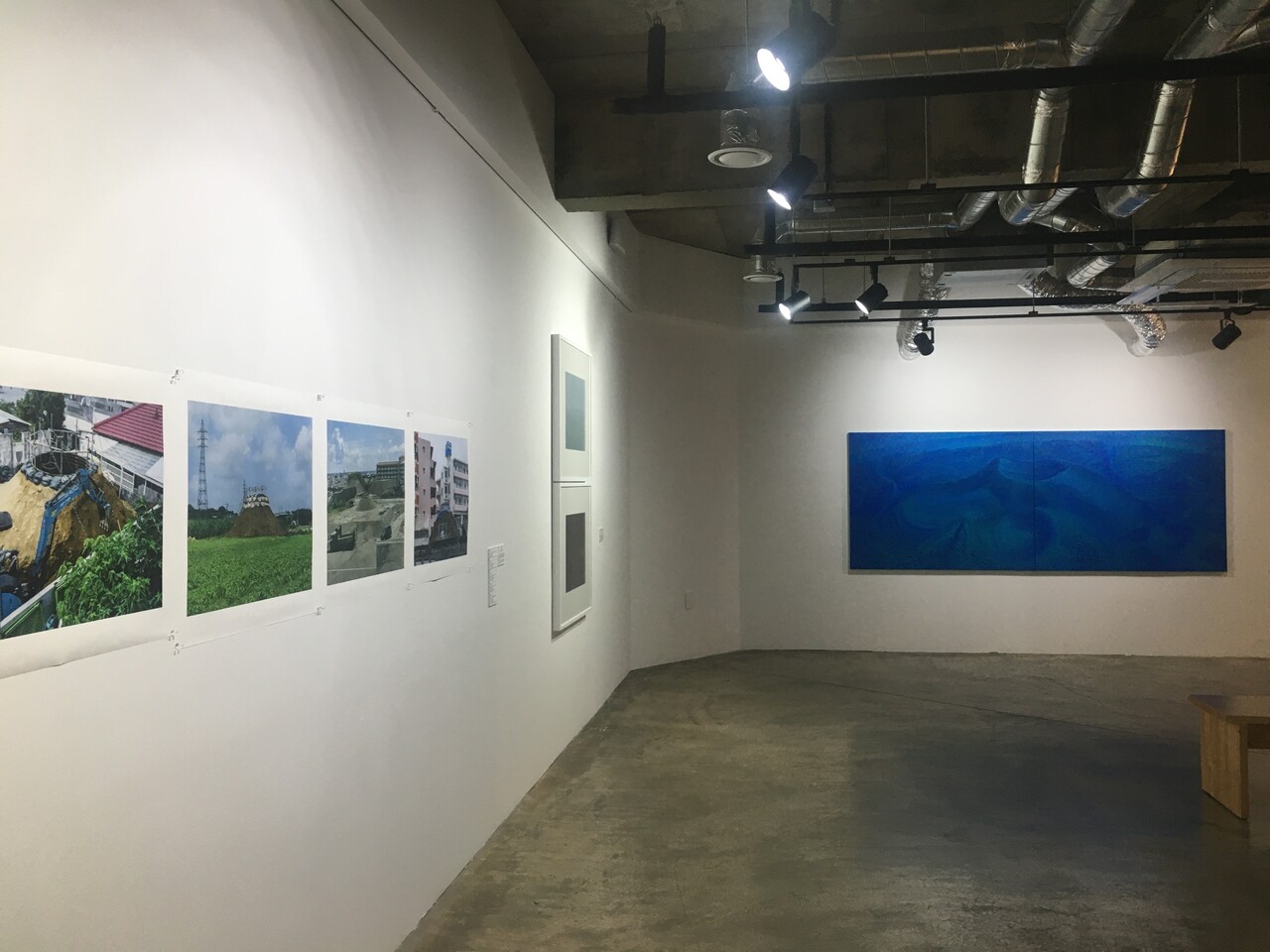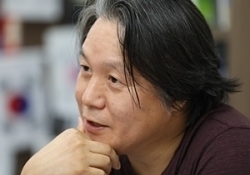[평화예술칼럼 Peace Art Column] (82) 김준기
| 제주도는 평화의 섬입니다. 항쟁과 학살의 역사를 가지고 있기에 평화를 염원하는 마음은 더욱 간절할 수 밖에 없습니다. 제주4.3이 그렇듯이 비극적 전쟁을 겪은 오키나와, 2.28 이래 40년간 독재체제를 겪어온 타이완도, 우산혁명으로 알려진 홍콩도 예술을 통해 평화를 갈구하는 ‘평화예술’이 역사와 함께 현실 속에 자리 잡고 있습니다. 이들 네 지역 예술가들이 연대해 평화예술운동을 벌이고 있습니다. 이들의 평화예술운동에 대한 창작과 비평, 이론과 실천의 공진화(共進化)도 매우 중요합니다. 독립언론 [제주의소리]가 네 나라 예술가들의 활동을 ‘평화예술칼럼(Peace Art Column)’을 통해 매주 소개합니다. 필자 국적에 따른 언어가 제각각 달라 영어, 일어, 중국어 번역 원고도 함께 게재합니다. [편집자 글] |

4.3미술제가 올해로 29회차를 맞았다. 예술공간이아와 산지천갤러리에서 열린 이번 전시 《제29회 4.3미술제: 봉인된 풍경》에는 제주도와 한반도 수도권과 광주, 여수의 작가들을 비롯해 하와이, 홍콩, 오키나와, 타이완 등의 국외 작가들까지 총 57인(팀)이 참여했다. 광주 5.18과 여수와 순천의 여순 10.19 등 이번 전시의 주제인 저항정신을 공유할 수 있는 도시의 작가들이 함께 한 것은 근 몇 년동안 정립한 항쟁 연대의 지속가능성을 보여준 것이다. 북서 태평양의 섬들에서도 항쟁의 역사를 공유하는 예술가들이 함께하여 제주4.3정신을 국제적 평화예술 연대의 장으로 이어나갔다.
지난해의 <어떤 풍경>에 이어 올해의 전시 제목에도 ‘풍경’이 들어간다. <봉인된 풍경>이다. 여기서 말하는 봉인된 풍경이란 드러내 보일 수 없어서 내놓고 말하지 못해온 상황들에 대한 은유적 표현이다. 봉인(封印)은 ‘밀봉(密封)한 자리에 도장을 찍다’라는 뜻을 가지고 있다. 봉투에 담아서 붙이고 그 자리에 도장을 찍어서 함부로 열어볼 수 없게 만든, 일종의 금기시하는 정보를 말한다. 봉인된 이야기들의 진실을 드러내지 않는다. 역사적 사실로만 존재할 뿐, 그것을 동시대적 가치로 공유하여 진실을 밝혀낼 수 없게 하는 것이 봉인의 효과다.

봉인의 시간을 넘어 진실의 역사를 만들어온 4.3미술제는 저항으로서의 예술에 초점을 맞추고 있다. 지난 해에 이어 올해도 민중의 저항을 다룬 연속 기획전이다. 4.3정신의 계승과 동시대적 소통을 목표로 하는 4.3미술제의 취지를 살려 시대정신으로 갈무리하려는 노력의 산물이다. 이 전시는 제주의 시공간에 서린 민중 저항을 다룬다. 역사적으로 제주는 탄압과 저항의 역사를 가지고 있으며, 제주4.3의 본질 역시 탄압에 맞선 저항이었다는 데 그 핵심이 있다. 공간적으로도 제주는 땅과 바다와 하늘에서 벌어지는 폭력에 의해 상처를 받아왔다. 따라서 이 전시는 시간의 축과 공간의 축을 따라 폭력에 맞선 저항으로 제주의 시공간을 재구성하고 있다.
제주의 역사는 곧 제주 주변의 역사와 병진해왔다. 오키나와와 타이완, 홍콩 등의 역사는 제국과 식민의 20세기 동아시아 및 전세계의 역사와 같은 궤적 위에 놓여있다. 이 전시 <봉인된 풍경>에 주목하고자 한 것은 바로 이 대목이다. 제주4.3의 가치를 섬의 이야기만이 아닌 세계사적 인식틀로 다시 보자는 것이다. 그리하여 봉투에 담아 풀을 붙이고 도장을 찍어 놓은 민중 저항의 4.3을 다시 들여다보자는 제안을 하고 있는 것이다. 그것은 긴 시간동안 우리가 들여다볼 수 없게 꽁꽁 숨겨놓은 의식의 봉투를 찢어버리고 4.3정신을 해방하자는 예술적 공론장이다.

올해의 전시는 4.3미술이 한국은 물론 국제적인 네트워크를 갖춰 평화예술 연대의 장으로 확장하고 있다는 것을 새삼 확인하게 해주었다. 오석훈의 <상실 시대 미완의 혁명>은 여전히 진행 중인 우리시대의 저항과 혁명에 관해 희망과 절망의 공존이라는 물음표를 던진다. 홍덕표의 <줄의 법칙, Joule's law>은 저항이 커지면 열기가 강해진다는 자연법칙을 토대로, 저항의 빛이 미래의 희망임을 이야기한다. 광주의 전정호는 광주 5.18미술이 선보여왔던 가장 전형적인 양식의 목판화로 제주4.3 저항의 상징인물을 표현했다. 여수의 화가 박금만은 마지막 유격대를 다룬 그림을 선보였다. 제주의 청년작가 김산은 켜켜이 쌓인 죽음의 상징으로 ‘돌아오지 않는 시간’을 표현했다.
타이완의 린이치(LIN YI-CHI, 林羿綺), 오키나와의 타이라 준(TAIRA Jun, 平良 淳), 홍콩)의 콩유윙(Kong Yiu Wing)과 룩밍(Lukming) 등 동아시아의 작가들과 더불어 하와이에서 활동하는 한인 예술가 클로이 강(Kloe Kang)의 작품은 제주의 봉인된 역사를 되짚어보게하는 것이었다. 30년 전에 하와이로 이주한 클로이 강(Kloe Kang)의 <보이지 않는 도시 제주 : Invisible Cities: Jeju 2022>는 드로잉과 비디오 설치 작업이다. 고난과 좌절이 가득했던 세기를 한반도의 독립 평화 그리고 인권을 위해 살아간 6인의 인물의 얼굴을 그렸는데, 그림을 그리고 지우고 변형하기를 반복하는 과정을 스톱모션 형식으로 만든 드로잉이다. 그가 다룬 인물들은 제주정신을 공유하는 인물들이 아스라한 과거의 이야기인 듯하면서도 동시대적 울림을 준다.

올해의 4.3미술제는 지난해에 이어 올해도 평화 연대를 이어나갔다. 지난해에는 미얀마의 군부독재에 대한 시민의 저항 정신에 연대하는 퍼포먼스와 성명, 부스 전시를 했다. 올해에는 러시아의 우크라이나 침공에 따른 전쟁을 규탄하고 평화를 염원하는 참여작가 성명 발표와 부스 전시를 열었다. 반전평화 부스는 제주의 4.3 정신을 동시대의 시대정신을 연결하는 장이다. 30회를 앞둔 4.3미술제의 역사가 초창기에는 억울한 죽음을 밝혀내고 해원하는 데 초점을 맞췄다면, 근래에 들어서는 동시대적 의제들을 기반으로 좀 더 넓은 틀에서 저항과 평화, 생명 등의 가치를 공유하는 장으로 확산하고 있다.
* 중국어 원고는 추후 게재될 예정입니다.
|
# 김준기 
홍익대학교 예술학 석사, 미술학 박사. |
4.3 Art as a Site of Peace Art Solidarity
GIM Jungi
This year marks the 29th anniversary of the 4.3 Art Festival. A total of 57 artists (teams) participated in the <29th 4.3 Art Festival: Sealed Landscape> exhibition held at Art Space IA and Sanjicheon Gallery, including artists from Jeju Island, the Korean Peninsula Capital Region,, Gwangju and Yeosu, as well as overseas artists from Hawaii, Hong Kong, Okinawa and Taiwan. The participation of artists from cities such as Gwangju 5.18 and Yeosun 10.19, who can share the spirit of resistance that was the theme of the event, shows the sustainability of the solidarity of resistance that has been established over the last few years. Artists who also share a history of resistance in the islands of the Northwest Pacific gathered to connect the Jeju 4.3 spirit with international peace art solidarity.
Following last year's <A Landscape>, the word 'landscape' is again in the exhibition title <Sealed Landscape> this year. The term 'sealed landscape' is a metaphorical expression for a situation that has been kept secret and has not been spoken of. Information that is sealed in an envelope and glued in place, so that it cannot be opened unnecessarily, becomes taboo. The truth of the sealed story is not revealed. The effect of sealing is to prevent the truth from being revealed, to prevent the true story from being shared with contemporaneous value, simply because it exists as historical fact.
The 4.3 Art Festival, which has made true history by transcending sealed time, focuses on art as resistance. Following on from last year, this year's exhibition was a series of exhibitions that focused on people’s resistance. It is the product of efforts to bring the spirit of the times to a close by utilizing the purpose of the 4.3 Art Festival, which aims to inherit the 4.3 spirit and communicate with the contemporaries. This exhibition deals with people’s resistance in the time and space of Jeju. The core of Jeju 4.3 lies in resistance to oppression.
Spatially, Jeju has been scarred by the violence that has unfolded on the ground, at sea and in the air. Therefore, this exhibition reconstructs the time and space of Jeju through the temporal and spatial axis of resistance to violence.
Jeju's history has paralleled that of its surroundings. The histories of Okinawa, Taiwan, Hong Kong and others are on the trajectory of 20th century East Asian and world history of empire and colonisation. It is precisely at this point that the exhibition focused its attention. It is about putting the value of Jeju 4.3 back into the framework of world historical perceptions, not just the story of an island. To this end, it proposes to reaffirm the sealed 4.3 of people’s resistance. It is an artistic public discourse that seeks to break the seal of consciousness that has been hidden for so long that we cannot look through it and liberate the 4.3 spirit.
This year's exhibition confirmed once again that 4.3 Art is expanding into a forum for peace art solidarity, with national and international networks. Oh Seok-Hoon's “Unfinished Revolution in the Lost Era” raises the question mark of ongoing resistance in South Korea and the coexistence of hope and despair for revolution. Hong Deok-pyo's 'Joule's Law' tells the story of how the light of resistance is the hope of the future, based on the natural law that the heat becomes stronger when resistance increases. Jeon Jeong-ho from Gwangju depicted the symbolic figures of Jeju 4.3 resistance in the most typical style of woodblock prints that Gwangju 5.18 Art has showcased. Yeosu painter Park Geum-man presented a work dealing with the last rangers. Jeju youth artist Kim Sang expressed 'time of no return' as a symbol of accumulated death.
In addition to East Asian artists such as Lin Yi-Chi, Taiwan, Taira Jun, Okinawa and Kong Yu-Wing and Lukming, Hong Kong, the work of Korean artist Kloe Kang, who works in Hawaii, reflected on Jeju's sealed history. 30 years ago, Kang moved to Hawaii, and her ‘Invisible Cities: Invisible Cities, Jeju 2022' is a drawing and video installation. It is a stop-motion drawing of the faces of six people who lived for independence, peace and human rights on the Korean peninsula during a century full of hardship and setbacks, and the process of repeatedly drawing, erasing and transforming their faces. The figures Kang dealt with seem to be a story of past figures who share the Jeju spirit and whose voices echo in the present day.
This year's 4.3 Art Festival continued the tradition of peace solidarity from last year. Just as last year's festival expressed solidarity with the spirit of civil resistance against the military dictatorship of Myanmar, this year's festival denounced the war caused by Russia's invasion of Ukraine, issued a statement by participating artists wishing for peace and held a booth exhibition. The anti-war and peace exhibition booth is a place to connect Jeju's 4.3 spirit with the contemporaries. If the history of the 4.3 Art Festival, which will be held for the 30th time next year, in its early years focused on lifting the veil of regrettable deaths, in recent years it has expanded into a space for sharing values such as resistance, peace and life in a broader framework based on the agenda of the same era.
1. Park So-yeon, ‘Dear Name’ crochet with silk yarn, variable installation, 2022
2. The installation work by Kim Young-hoon and t photographic works by Noh Seung-Taek
3. Photography by Taira Jun and paintings by Park Young-gyun.
4. Chloe River (resident in Hawaii), Invisible Cities: Jeju, drawing and video installation, 3'00'' 2022
平和芸術連帯の場としての4.3美術
ギム・ジュンギ
4.3美術祭が今年で29回目を迎えた。アートスペース・イアとサンジッチョン・ギャラリーで開かれた<第29回4.3美術祭:封印された風景>展に、済州島と韓半島首都圏、光州、麗水の作家、ハワイ、香港、沖縄、台湾の海外作家を含めて計57人(チーム)が参加した。光州5.18と麗順10.19のように今回のテーマである抵抗精神を共有できる都市の作家が参加したのは、ここ数年間で確立した抵抗連帯の持続可能性を示している。北西太平洋の島々で抗争の歴史を共有する芸術家たちが、済州4.3精神を国際平和芸術連帯の場を繋ごうと集まった。
昨年の<ある風景>に続き、今年も展示タイトル<封印された風景>に「風景」という言葉がある。<封印された風景>とは、秘匿され語られなかった状況の隠喩的な表現だ。封筒に入れて糊付けした場所に印を押し、むやみに開けられないようにされた情報はタブーと化す。封印された話の真実は表に出されない. 歴史的事実として存在するだけで、真実の物語を同時代的な価値で共有させない、真実を明らかにできないようにする、それが封印の効果だ。
封印された時間をのり越えて真実の歴史を作ってきた4.3美術祭は、抵抗としての芸術に焦点を合わせる。昨年に続いて今年も民衆の抵抗を取り上げた連続企画展となった。それは、4.3精神の継承と同時代的コミュニケーションを目指す4.3美術祭の趣旨を、時代精神に近づけようとする努力の産物だ。本展は済州の時空間に漂う民衆抵抗を扱う。済州4.3の核心は弾圧への抵抗という点にある。空間的にも済州は地と海と空で繰り広げられる暴力に傷ついてきた。 それゆえ本展は、暴力への抵抗という時間軸と空間軸によって、済州の時空を再構成するものとなった。
済州の歴史は周辺の歴史と並進してきた。沖縄、台湾、香港などの歴史は、帝国と植民という20世紀の東アジアと世界史の軌跡の上にある。本展が注目したのはまさにこの部分だ。済州4.3の価値を、単なる島の物語でなく、世界史的認識の枠組みに戻そうということだ。そのため、封筒に入れて糊付けされ封印された民衆抵抗の4.3を再確認しようと提案しているのだ。 それは、私たちがのぞき込めないように長い間隠されていた意識の封を破り、4.3精神を解放しようという芸術的公論の場だ。
今年の展示は、4.3美術が国内はもちろん国際的なネットワークを持ち、平和芸術連帯の場に拡張していることをあらためて確認させてくれた。オ・ソッフンの「失われた時代の未完の革命」は、韓国において依然として進行中の抵抗と革命への希望と絶望の共存という疑問符を投げかける。ホン・ドッピョの「ジュールの法則」は、抵抗が大きくなるほど熱気が高まるという自然法則に基づき、抵抗の光が未来の希望であることを物語る。光州のチョン・ジョノは、光州5.18美術が披露してきた最も典型的な様式の木版画で、済州4.3の抵抗の象徴的人物を表現した。麗水の画家パク・クムマンは最後の遊撃隊を扱った作品を披露した。済州の青年作家キム・サンは、堆積した死の象徴として「帰らざる時間」を表現した。
台湾の林羿綺、沖縄のタイラ・ジュン、香港のコン•ユウィングやルッ・ミングなどの東アジアの作家に加えて、ハワイで活動する韓国人芸術家クロイ•カンの作品は、済州の封印された歴史を振り返るものだった。30年前にハワイに移住したカンの「済州の見えない都市:Invisible Cities, Jeju 2022」はドローイングとビデオのインスタレーションである。苦難と挫折に満ちた世紀に、韓半島の独立平和、そして人権のために生きた6人の人物の顔を描いては消し、変形することを繰り返す過程をストップモーション形式で作ったドローイングだ。カンが扱った人物は済州精神を共有する過去の人物たちが現代に声を響かせている物語のように思える。
2022今年の4.3美術祭は、昨年に続き今年も平和連帯を継承した。昨年はミャンマー軍部独裁に対する市民の抵抗精神に連帯したように、今年はロシアのウクライナ侵攻による戦争を糾弾し、平和を願う参加作家声明を発表しブース展示を開催した。反戦平和展示ブースは済州の4.3精神を同時代の時代精神とつなぐ場だ。来年で30回となる4.3美術祭の歴史が、その初期は無念の死のベールをはいで解明することに焦点を合わせたとすれば、近年は同時代の議題を基盤とするより広い枠組みで、抵抗と平和、生命といった価値を共有する場へと拡張している。
1. パク・ソヨン 「親愛なる名前」 絹糸のかぎ針編 可変インスタレーション 2022
2. キム・ヨンフンのインスタレーションとノ・スンテクの写真作品
3. タイラ・ジュンの写真作品とパク・ヨンギュンの絵画作品
4. クロイ・カン(ハワイ在住) Invisible Cities: Jeju ドローイングとビデオのインスタレーション 3’00’’ 2022

